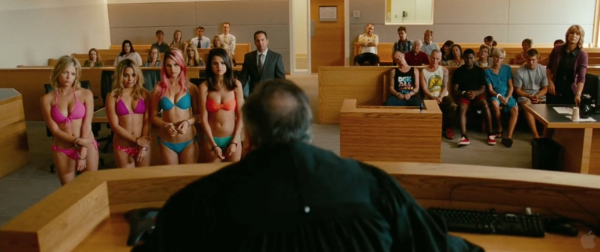1928 // USA // John Ford // April 8, 2013 // DVD - 2007 (Fox)
[Note: This post contains spoilers. Part of a series on the silent films of John Ford.]
Although John Ford’s surviving early films adhere quite rigorously—even stuffily, at times—to the parameters of Silent Era Hollywood melodrama, the director always seemed to find opportunities to inject idiosyncratic moments into his features. In Just Pals (1920) and The Iron Horse (1924), such moments manifested chiefly as striking formal flourishes or shamelessly lovely shots dropped into lulls in the action. With 3 Bad Men (1926), Ford and the writers at Fox began to doodle a bit more at the edges of story, indulging in just enough digressions from the usual America cinematic formulae to leave a faint impression of artistic restiveness. A touch of both visual and screenwriting verve is in evidence in the 1928 continent-spanning family epic Four Sons, adapted by Philip Klein and Herman Bing with titles by H.H. Caldwell and Katherine Hilliker.
The film’s source is the 1926 Saturday Evening Post short story “Grandmother Bernie Learns Her Letters” by now-obscure Australian-British-American novelist I. A. R. Wylie. The prolific Wylie was one of the more widely adapted female authors of the early twentieth century, although she is most renowned for penning the work that became George Cukor’s 1942 tragedy about American fascism, Keeper of the Flame. In “Grandmother Bernie”, Klein and company find an appealing, sentimental tale of the U.S. Melting Pot, a promised land of second chances and subsumed (but retained) ethnic identity. Four Sons is therefore of a piece with the generalized nationalist myth-making that characterizes Ford’s prior films, particularly The Iron Horse. In the case of the Four Sons, the celebration of America’s patchwork, prosperous character is quite explicit, but also intertwined with a modest anti-war and pro-immgrant message.
The film opens at the dawn of the Great War in an idyllic Bavarian village, a tidy picture postcard settlement populated with fresh-faced Teutonic lads and lasses (the former all in lederhosen, naturally) and provincial comic relief characters. These include: a doddering Burgomeister (August Tollaire); a bookish Schoolmaster (Frank Reicher); a blustering, rotund Innkeeper (Hughie Mack); and an overweening yet kind-hearted Postman (Albert Gran) who is constantly fiddling with his impressive handlebar mustache. The unofficial center of village life is Mother Bernie (Margaret Mann), an elderly widow with four strapping sons and a bottomless supply of misty-eyed maternal devotion. Naturally, the Bernie Boys are uniformly handsome but divergent in their character. Eldest son Joseph (James Hall) is an upstanding soldier in the imperial garrison, Johann (Charles Morton) a fun-loving layabout, Franz (Ralph Bushman) a hard-working blacksmith, and Andreas (George Meeker) a gentle shepherd. Raising such fine specimens of Bavarian manhood is sufficient to earn Mother Bernie the lasting admiration of her fellow villagers, and her sweet, devout disposition and accomplished talents as a baker elevate her to the status of local saint.
A shadow begins to encroach on this pastoral paradise, however, with the arrival of the new commander of the garrison, the aristocratic Major von Stomm (Earle Fox). The officer is quickly revealed as a high-handed and bloodthirsty bastard, eager to turn Bavaria’s sons into hardened cogs in the Kaiser’s war machine. (He even wears a monocle, cinematic shorthand for Cartoonishly Evil German Officer until Grand Illusion’s von Rauffenstein came along.) Following an unpleasant run-in with the Major, shiftless Son Number Two Johann receives a letter from an American friend, and thereafter confesses to his mother a desire to cross the Atlantic in search of a fresh start. Mother Bernie, being a selfless parent, slips Johann the money he needs for the journey from her own modest stash of funds. In short order, the fresh-off-the-boat Johann is settling in as a delicatessen worker in New York City, wooing a vivacious American girl named Annabelle (June Collyer), and sending letters home that enthuse on the golden opportunities of Yankee life.
Back in Bavaria, however, the Great War reaches into Mother Bernie’s household and spirits both Joseph and Franz off to the front lines, leaving only Andreas to look after his old Mutter. Eventually the day comes that Mother Bernie feared but did not dare contemplate: the Postman, head downcast, delivers the dreaded black-bordered envelope reserved for official letters of condolences from the German Army. The loss of Joseph and Franz casts an undeniable pall over Mother Bernie's now-lonely household and the village as a whole, but the widow endures through her grief. Meanwhile, Johann has thoroughly assimilated into American life, taking over as owner of the delicatessen, marrying his beloved Annabelle, and fathering a son of his own. When the U.S. finally enters the War, Johann anxiously but willingly answers the call, shipping off to Europe to stand against the nation of his birth.
Shortly after word of Johann’s enlistment in the American ranks arrives in Bavaria, Major von Stromm appears at Mother Bernie’s home to convey his official contempt for her son’s treasonous ways. To Mother Bernie’s anguish, von Stromm orders that Andreas must be drafted in order to compensate the Fatherland for Johann’s betrayal. Some weeks later, as new American doughboy Johann hunkers down in the mist-shrouded trenches of a muddy battlefield, he hears a fatally wounded German soldier calling out in agony for his mother. Moved by the man’s cries, Johann crosses the No Man’s Land and discovers—shocker!—that the dying man is his youngest brother Andreas. Armistice Day follows soon after, and the reviled von Stromm finds himself facing a de facto fragging: his mutinous enlisted men offer him a loaded pistol, urge him to “do the right thing,” and shut the door with a smirk. The War’s end should be a joyous occasion for Mother Bernie, but another black-bordered letter arrives, announcing Andreas’ death and nearly extinguishing what little maternal strength she still possesses.
The war-weary Johann arrives back in the U.S. to find that his newborn son has grown into a fine boy and his business ventures have thrived under Annabelle’s shrewd oversight. Now that his brothers are gone, Johann is resolved to bring his mother to America’s blessed shores to live out the remainder of her days in comfort. Mother Bernie finally receives some overdue good news from the Postman with the arrival of Johann’s letter, initiating the film’s final act. It’s at this point that the tone of Four Sons shifts from a wrenching wartime tearjerker to a mildly screwball tale of Old World to New World hiccups. The U.S.’ literacy regulations for new citizens necessitate that Mother Bernie learn the alphabet, resulting in a sweet and silly scene where the local children provide clandestine support during her schoolroom quiz. Eventually, Mother Bernie makes the crossing and alights at Ellis Island, where her nerves get the better of her during the examination, resulting in an overnight detention. Johann arrives to demand that his parent be released, but due to a series of mix-ups, Mother Bernie slips away into the streets of New York City. The widow wanders Manhattan in a daze, asking random passers-by in broken English if they know her Johann. Fortunately, her odyssey does not last long. The police deposit Mother Bernie at the doorstep of her son’s swanky apartment, where Johann and Annabelle later find her snoozing before the fireplace, with her grandchild cuddled in her lap.
First and foremost, Four Sons is a moralizing celebration of maternal love as the most righteous of emotions. A mother's devotion might be battered by unthinkable tragedy but will ultimately be rewarded for its purity and perseverance. The film also functions as an earnest paean to post-War American ideals, one that shines an unmistakably positive light on the immigrant's can-do spirit and their eventual absorption into the national fabric. To contemporary eyes, such a stance might seem mildly paternalistic, but in 1928, Ford’s film would likely have been seen as progressive in its portrayal of “good” German-Americans. World War-era nativist loathing for the “filthy Hun” was at its peak only a decade prior. While Four Sons goes out of its way to lionize Johann’s efforts to Americanize—he changes his establishment’s name from “German-American Deli” to “Liberty Deli” after April 1917—it also offers an empathetic view of the German people that calls attention to the universal nature of their virtues and foibles. (What could be more catholic than a mother’s love, after all?) This is consistent with the broad affection that Ford often displayed for “hyphenated-Americans” in his early films—evidenced in his depiction of the rough-edged nobility of the Irish in The Iron Horse and 3 Bad Men—while also presaging the manner in which the director’s work would wrestle with racism in the ensuing decades.
Four Sons cannot be properly regarded as a war picture, as the actual battlefield sequences comprise only a fraction of the picture’s 96-minute running time. All the same, the film contains an undeniable (if ambiguous) streak of anti-war sentiment that emerges from the same moral locus as its humane portrayal of the German people. The loss of Mother Bernie’s three sons is depicted as a senseless waste, one that results from patrician lust for wartime glory and the hubris of German commanders who thought their armies invincible. The film’s sympathies are unequivocally with the grief-stricken mothers who are left behind, rather than with the warmongers who insist that it is sweet and right for Bavarian boys to die for their country. One can’t say with a straight face that the film is exactly searing in its indictment of war—All Quiet on the Western Front it’s not. At one point the intertitles even regress to the romanticism of Ford’s earlier pictures in describing the war as a “great adventure”. Still, there is a potent sense of empathy for the Enemy that pervades the script. In one of the film’s most delicately forlorn moments, a fellow American soldier quietly observes to Johann as Andreas’ wails drift across the lines: “I guess those fellows have mothers too.”
If Four Sons has a narrative misfire, it lies in the eventual evolution into a mildly farcical story about Mother Bernie’s journey to the United States. The stumble is not one of tone, as the film exhibits throughout its running time an affinity for employing both sincere emotion and broad comic silliness, often in the same scene. It’s simply that the “Mother Bernie Comes to America” scenes feel almost entirely like wheel-spinning, an effort to delay the old widow’s just reward for her motherly faithfulness in the name of dramatic effect. Granted, the entire film is constructed to highlight the poignancy of Mother Bernie’s sufferings, often by exploiting knowledge that the viewer possesses but the characters do not. (The arrival of the letter announcing Andreas’ death on Armistice Day is a especially sadistic slow-motion stab in the heart.) Accordingly, what’s problematic about the film’s later propensity to throw up obstacles to the mother-son reunion is not its cruelty but its tiresomeness. Four Sons is, after all, a 1920s Hollywood picture, meaning that it is not a question of whether there will be a happy ending, but how exactly it will play out. Eventually, one just wants to see Johann and his mother embrace and be done with it.
In keeping with Ford’s other surviving silent features, Four Sons boasts quite a few strange little gestures that mark it as the work of a filmmaker of increasing confidence and imagination. There are too many to catalog exhaustively, but a few are worth highlighting due to the significant impression they make on the viewer in the moment. There’s the authentic joy that the director conveys in the depiction of Johann’s early domestic bliss, particularly when his chubby, squirming newborn son knocks over a water basin to the exasperation and amusement of his parents. There is phantom slap from Major von Stromm that strikes Johann when he reads a newspaper account of German military movements—a ghostly memory from across the Atlantic that prompts the immigrant to rub his cheek absently. And, most memorably, there is the mesmerizing comic mugging of a German soldier as he coaxes von Stromm to suicide, punctated with an almost vaudevillian exit through the door. In addition to Ford’s astonishing ease with a complex, world-spanning story, it’s terrific moments such as these that make Four Sons a pleasure, turning run-of-the-mill Silent Era drama into something more indelible.









